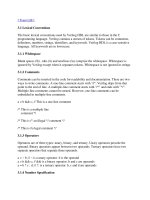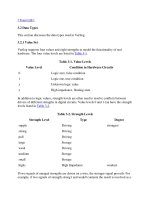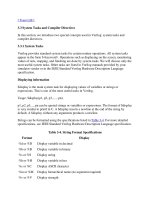Basic concepts some common misconceptions
Bạn đang xem bản rút gọn của tài liệu. Xem và tải ngay bản đầy đủ của tài liệu tại đây (3.91 MB, 36 trang )
Refresher Programme for Geography Teachers
Plate Tectonics Theory:
Basic Concepts & Some
Common Misconceptions
Chan Lung Sang
Department of Earth Sciences
Faculty of Science, HKU
地地
( 地地地地地地地地地地地地地地地地地地地地 )
地地
( 地地地地地地 )
地地
( 地地地地地地地地地地地地地地地地地地地 )
Landform and Endogenetic Processes
Part 1: Plate Tectonics
• History of Development
• Basic Concepts
–
–
–
–
–
Earth’s interior model
Crustal provinces & structures
Rock formation
Energy sources
Mineral and oil formation
• Tectonics and Geology of Hong Kong Region
[MANY OF THE FIGURES USED IN THIS PRESENTATION WERE
DOWNLOADED FROM THE INTERNET. THEIR CREATORS , OFTEN
ANONYMOUS, ARE GRATEFULLY ACKNOWLEDGED]
1. From Continental Drift
to Plate Tectonics
Alfred Wegener
•
•
•
•
Paleoclimate
Fossil evidence
Geological evidence
Coastline geometry
Birth of the Plate Tectonics Theory
Plate tectonics theory was founded upon the
following new findings in the late 1960s:
• Ocean floor topography
• Marine magnetic anomalies
• Paleomagnetism & geomagnetic field
reversals
• Sea floor spreading
Plate Boundaries, Earthquakes and Major
Volcanoes of the World
* Note new designation of plate boundary at Japan.
Plate Boundaries
* Note associated landforms: axial rift at mid-ocean ridge,
sea trench at subduction zone, sea mounts and island arc.
A paradigm shift - A unifying theory accounting for
•Earth’s interior structure
•Origin of atmosphere & hydosphere
•Crustal structures and provinces
•Volcanism & earthquakes
•Rock record
•Fossil record
•Sedimentary basins
•Petroleum and mineral formation
•Geophysical fields
2. Earth’s Interior Structure
Studying Earth’s Interior
Earth scientists use the following techniques to determine
Earth’s interior structure
•
•
•
•
•
•
•
•
Earthquake waves
Whole-earth free oscillation
Rock records
Meteorite compositions
Geomagnetism
Heat flow & geothermal gradient
Lab experimentation
Numerical modeling
Earth’s Abundance
• Four major elements: O, Fe, Si, Mg 85%
• Only 3% S
• Earth’s crust depleted in siderophile (Fe, Ni,
Cu etc.) but enriched in K and Al
• Mantle - Mg silicate
• Core – FeS, FeO and Fe
* Mantle is not liquid; convection occurs due to material rheology.
Earth’s Interior Model
Shell
Name
Depth (km)
Composition
State
A
Crust
0-30
Al-rich silicate
solid
B
C
Noncrustal
Lithosphere
Asthenosphere
Upper
Mantle
30-100
100-640
D’
Lower Mantle
640-2800
D”
Mantle-Core Transition
2800-2890
E
Outer Core
2890-4600
F
OC-IC Transition
4600-5160
G
Inner Core
5160-6370
solid
Mg-rich
silicate
(olivine)
near melting
solid
soild (softer)
FeS+Fe
Fe+FeO
liquid
liquid+solid
solid
Earlier idea on crustal structure
* The concepts of sial and sima are old and imprecisely
describe current understanding of crustal structure.
*Lithosphere includes the crust and part of the upper mantle.
Asthenosphere is not a molten layer.
*Note deepening of Moho beneath mountains due to isostasy.
* The distinction between lithosphere and asthenosphere is by
means of physical strength, not composition
3. Crustal Provinces &
Structures
Crustal provinces and
structures at different
scales are results of
tectonic evolution and
associated stress system
Growth of North
America Continent
地地地地地地地地地
地地地地地地地地地地
地地地地地地地地地地地地地
Most folded
mountain belts
are continental
suture zones
Structures on smaller scale
Overturned syncline
Graben structure
Tension gashes
Plunging S-fold
4. Rock Formations
Rock Cycle in Plate Tectonics Context
Igneous & Metamorphic Rocks
* Most magmas form from melting of mantle and crustal
material in the overriding plate and not the descending plate.
Ophiolite:
suite of oceanic crust and mantle rocks
Pillow basalt intruded by mafic dikes, Cyprus









